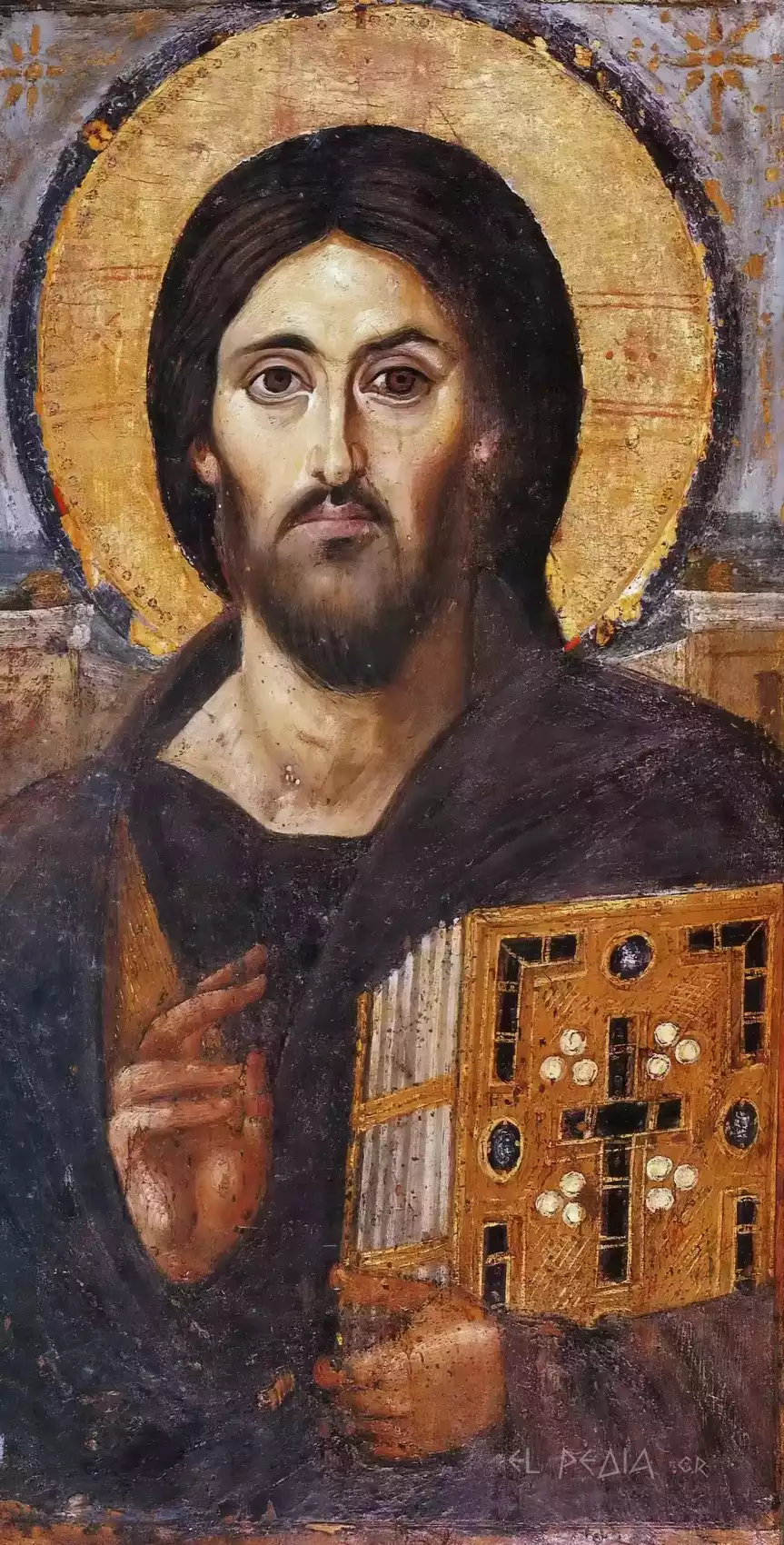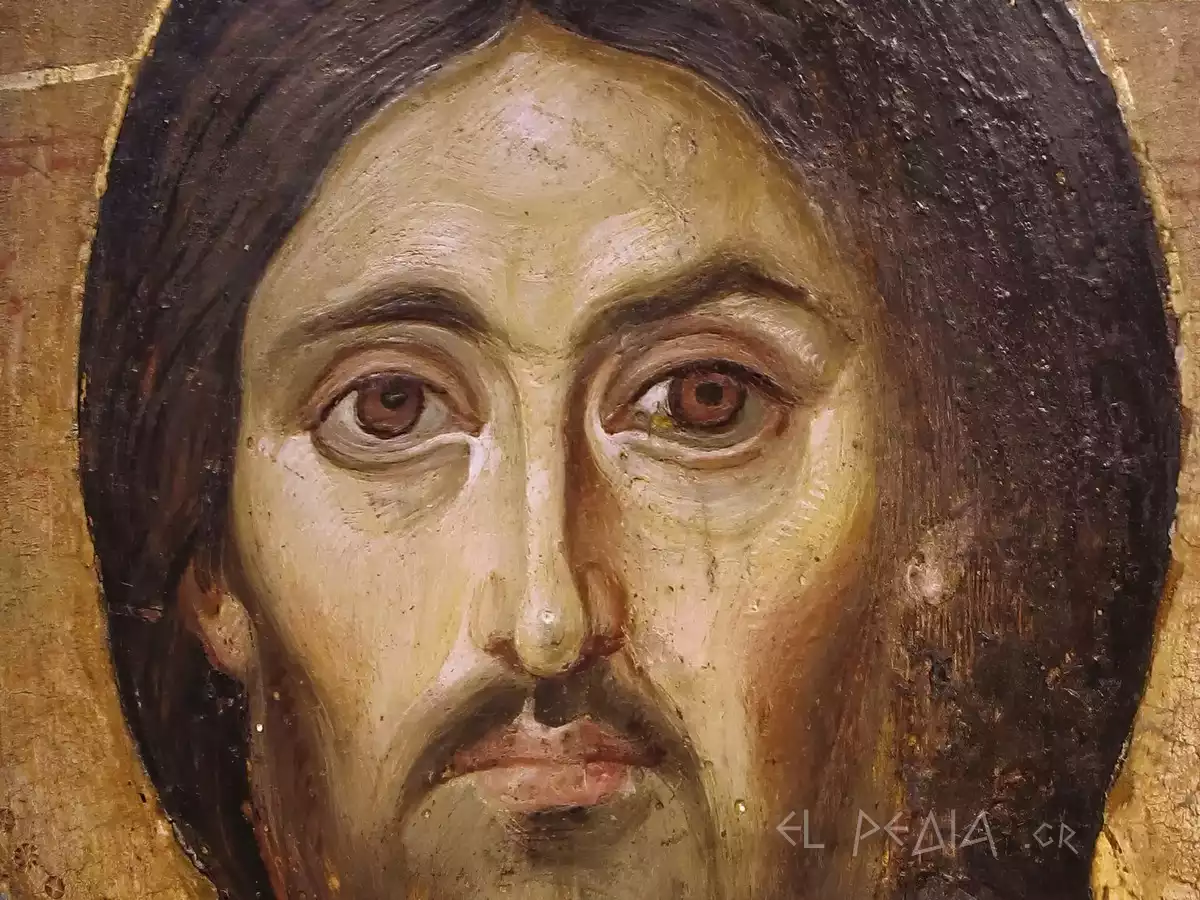
Title: Christ Pantocrator
Artist: Unknown Byzantine Artist
Type: Religious Icon, Encaustic Technique
Date: 540-560 AD
Dimensions: 84 x 45.5 cm
Materials: Encaustic on wooden panel
Location: Monastery of Saint Catherine, Mount Sinai, Egypt
The Pantocrator of Sinai stands as a paramount early Byzantine icon. Its ejecutor was not the artistic brilliance of the 6th century but that of the 8th or 9th. Despite its lack of early Byzantine artistic merit, the Pantocrator has survived, uncannily, to our very doorsteps. Most surviving early Byzantine art must be reconstructed in our imaginations rather than seen. Very few constants remain in the early iconographic grammar of art that early Byzantium handed down to us. The grammar and the art were almost completely dismantled and didn’t survive the various Puritanical iconoclastic assaults on both art and artists in Byzantium during the 8th and 9th centuries. They were reconstituted with very little direct evidence during the 10th, 11th, and 12th centuries.
The Virgin Mary is represented in an icon type known as the Hodegetria, or the “she who shows the way.” In the Hodegetria, Mary holds the Christ Child in her left arm, while with her right hand, she points to him. Although she is theernnavior, the image very much focuses on the Child. He is not always a small, unmoving figure, but can be fully aware of who and what he is. The figure cannot just be a foil to his Mother, because he is in the image. He is the second person of the Trinity and if not fully divine, then at least fully human.
Encaustic Technique and Artistic Rendering
The encaustic technique used in the Pantocrator of Sinai is an excellent example of the high art of the early Byzantine period. This method, which involves the use of hot wax mixed with pigments, allowed the artist to create impressive depths and transparencies in the rendering of Christ’s face. This technique, which requires exceptional skill and speed in application, allows for the creation of thin layers that create a unique brightness and vibrancy on the surface of the icon.
The artistic rendering of the work is characterized by an astonishing balance between naturalistic elements and spiritual symbolism. The anatomical details of the face, the rendering of volume, and the modeling of features testify to the influence of the Greco-Roman tradition, while at the same time, the Byzantine art highlights the divine nature of the depicted figure (K Corrigan). The color palette, with the dominance of the golden background and the deep tones in Christ’s garment, creates a sense of transcendence that characterizes Byzantine iconography.
The detailed processing of the facial features reveals the artist’s exceptional technical training, who managed to render the expression of the Pantocrator with impressive accuracy. The asymmetry of the face, which is one of the most discussed features of the work, is not accidental but a deliberate choice by the artist to convey the dual nature of Christ. The right side of the face, with its strict and imposing expression, symbolizes the divine nature, while the left, with its gentler and compassionate expression, represents Christ’s human nature.
The dimensions of the work, 84 x 45.5 centimeters, make the icon particularly impressive for its time. The use of the encaustic medium allowed the artist to create extremely fine gradations in skin tones and to render with remarkable detail elements such as Christ’s beard and hair, while this technique also contributed to the excellent preservation of the work to this day.
Theological Symbolism and Influence of the Pantocrator
The image of the Pantocrator at Sinai is a milestone in the evolution of Byzantine art and theological iconography. The work expresses a unique synthesis of Eastern and Western elements, creating a new visual vocabulary that profoundly influenced later Byzantine art. The golden background, which dominates the image, is not merely a decorative element but symbolizes divine light and eternity.
The presence of the decorated Gospel in Christ’s left hand and the gesture of blessing with the right are central elements of the monastic treasure preserved at Sinai (M ASPRA-VARDAVAKI). The Gospel, richly decorated with precious stones, underscores the importance of the divine word, while the gesture of blessing expresses the Pantocrator’s direct relationship with the faithful.
The symbolic dimension of the image extends beyond the obvious elements of the composition. In the rendering of the halo, the artist used different shades of gold, creating an impressive sense of depth that enhances the transcendent dimension of the figure. The choice of dark blue tunic and brown mantle is not accidental, as it reflects the tradition of imperial purple, adapted to the theological context of the time.
The influence of the image of the Pantocrator of Sinai on later art was catalytic. This composition established a standard for the depiction of Christ that influenced not only Byzantine art but also Western medieval art. The subtle gradations in the rendering of facial features, the balanced use of light and shadow, and the dynamic relationship between naturalistic and symbolic elements created a standard that influenced generations of artists.

The Psychological Dimension of the Face
The detail of the Pantocrator’s face reveals the artist’s exceptional skill in rendering human features. The eyes, with their intense and penetrating gaze, dominate the composition. They are large, expressive. The beard is rendered with fine strokes that create a natural texture.
The asymmetry of the face is evident in this detail. The right side appears more severe, with a slightly raised eyebrow and more intense shading. The left side, in contrast, is gentler in expression, with softer gradations in shading and a sweetness in the gaze.
The encaustic technique allowed the artist to create extremely fine gradations in skin tones. The shadows around the eyes, nose, and lips create a sense of depth and volume that gives the face an almost three-dimensional quality. The brown eyes, with the fine strokes in the iris, create an impression of vitality and intensity that has been preserved even after fifteen centuries.
The inscription “EL REALIA GR” visible at the bottom of the detail is a later addition. Noteworthy is the preservation of colors, especially in the facial areas where the flesh tones remain vibrant and bright. This is due to the durability of the encaustic technique, where the wax acts as a protective medium for the pigments.
Pantocrator of Sinai – Timeless Legacy
The Pantocrator of Sinai remains one of the most important works of early Byzantine art, reflecting the transitional period from Greco-Roman to Christian art. Its exceptional preservation allows us to study the technical and aesthetic choices of 6th-century artists with unique detail. This image is a living testimony to the transition from the naturalism of classical art to the spiritual symbolism of the Byzantine tradition.
The influence of the work extends beyond the boundaries of the Byzantine Empire, affecting the development of religious art both in the East and the West. The technical perfection, psychological insight, and symbolic richness of the work make it a timeless model of artistic expression.
elpedia.gr
Bibliography
Corrigan, K. Visualizing the Divine: An Early Byzantine Icon of the ‘Ancient of Days’ at Mt. Sinai.” Art and Liturgy at St. Catherine’s Monastery in the Sinai (2011).
ASPRA-VARDAVAKI, M. “Christ Pantocrator. A comnenian icon in the monastery of St Catherine, Sinai.” Bulletin of the Christian Archaeological Society (2002).

